ON THE ROOTS OF EDGE COVER POLYNOMIALS OF GRAPHS
advertisement
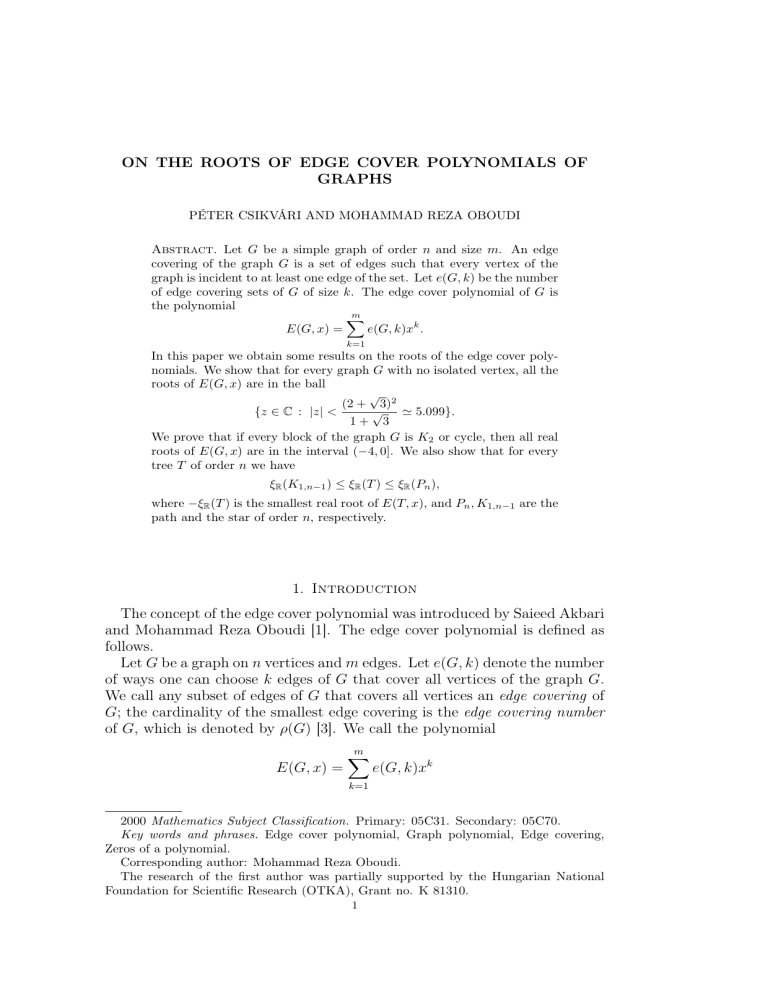
ON THE ROOTS OF EDGE COVER POLYNOMIALS OF
GRAPHS
PÉTER CSIKVÁRI AND MOHAMMAD REZA OBOUDI
Abstract. Let G be a simple graph of order n and size m. An edge
covering of the graph G is a set of edges such that every vertex of the
graph is incident to at least one edge of the set. Let e(G, k) be the number
of edge covering sets of G of size k. The edge cover polynomial of G is
the polynomial
m
X
e(G, k)xk .
E(G, x) =
k=1
In this paper we obtain some results on the roots of the edge cover polynomials. We show that for every graph G with no isolated vertex, all the
roots of E(G, x) are in the ball
√
(2 + 3)2
√
{z ∈ C : |z| <
≃ 5.099}.
1+ 3
We prove that if every block of the graph G is K2 or cycle, then all real
roots of E(G, x) are in the interval (−4, 0]. We also show that for every
tree T of order n we have
ξR (K1,n−1 ) ≤ ξR (T ) ≤ ξR (Pn ),
where −ξR (T ) is the smallest real root of E(T, x), and Pn , K1,n−1 are the
path and the star of order n, respectively.
1. Introduction
The concept of the edge cover polynomial was introduced by Saieed Akbari
and Mohammad Reza Oboudi [1]. The edge cover polynomial is defined as
follows.
Let G be a graph on n vertices and m edges. Let e(G, k) denote the number
of ways one can choose k edges of G that cover all vertices of the graph G.
We call any subset of edges of G that covers all vertices an edge covering of
G; the cardinality of the smallest edge covering is the edge covering number
of G, which is denoted by ρ(G) [3]. We call the polynomial
E(G, x) =
m
X
e(G, k)xk
k=1
2000 Mathematics Subject Classification. Primary: 05C31. Secondary: 05C70.
Key words and phrases. Edge cover polynomial, Graph polynomial, Edge covering,
Zeros of a polynomial.
Corresponding author: Mohammad Reza Oboudi.
The research of the first author was partially supported by the Hungarian National
Foundation for Scientific Research (OTKA), Grant no. K 81310.
1
2
PÉTER CSIKVÁRI AND MOHAMMAD REZA OBOUDI
the edge cover polynomial of the graph G. Clearly, if the graph G has an
isolated vertex then the edge cover polynomial is 0. We let E(G, x) = 1
when n = m = 0.
Our motivation is the following question posed by László Lovász [13].
Question: Is there any upper bound for the roots of edge cover polynomials?
We answer this question affirmatively. We will prove the following theorems.
Theorem
3.1 All roots of the edge cover polynomial lie in the ball {z ∈ C :
√
(2+ 3)2
|z| < 1+√3 }.
Recall that the block of a graph is a maximal induced subgraph without
cut-vertex.
Theorem 4.5 Let G be a graph of order n. If every block of G is K2 or
cycle, then all real roots of E(G, x) are in the interval [−2 − 2 cos πn , 0].
There are many papers on the locations of the roots of other graph polynomials such as chromatic polynomial, matching polynomial, independence
polynomial, characteristic polynomial. In [16], Thomassen showed that
the chromatic polynomials have no root in the intervals (−∞, 0), (0, 1) and
(1, 32
]. Moreover, he proved that the roots of the chromatic polynomials are
27
, ∞). He also showed that if the chromatic polydense in the interval [ 32
27
nomial of a graph has a non-integer root less than or equal to 1.29559...,
then the graph has no Hamiltonian path [15]. In [4], Brown, Hickman, and
Nowakowski proved that the real roots of the independence polynomials are
dense in the interval (−∞, 0], while the complex roots are dense in the complex plane. There are many results on the roots of the matching polynomials
as well. In [10], it was proved that all roots of the matching polynomials are
real. Also it was shown that if a graph has a Hamiltonian path, then all
roots of its matching polynomial are simple (see Theorem 4.5 of [8]). It
is well known that all roots of the characteristic polynomials are real. For
every tree, the matching polynomial and the
√ characteristic polynomial are
equal to each other [8]. Since for every n, n is a root of the characteristic polynomial of K1,n+1 , we can conclude that there is no constant bound
for the roots of the characteristic polynomials and matching polynomials.
For more details on characteristic polynomials see [5]. There are also many
bounds for the roots of these polynomials in terms of other parameters of the
graphs. For instance, in [14] Sokal proved that for every graph G, the absolute value of any root of the chromatic polynomial of G is at most 8∆(G),
where ∆(G) denotes the maximum degree of the graph G. On the other
hand, χ(G) − 1 is clearly a root of the chromatic polynomial where χ(G) denotes the chromatic number. Therefore, there is no constant bound for the
roots of these polynomials (chromatic polynomial , matching polynomial,
independence polynomial, characteristic polynomial). Surprisingly, in this
ON THE ROOTS OF EDGE COVER POLYNOMIALS OF GRAPHS
3
paper, we will show that there is a constant bound for the roots of the edge
cover polynomials.
Recently, Averbouch, Godlin, and Makowsky [2] introduced a new graph
polynomial, the edge elimination polynomial that is denoted by ξ(G, x, y, z),
for every graph G, which generalizes some well known graph polynomials such as (di)chromatic polynomials, matching polynomials, independence
polynomials, and Tutte polynomials. Using Theorem 4 of the paper [2] one
can easily see that this graph polynomial generalizes the edge cover polynomial as well. In fact, for every graph G, we have E(G, x) = ξ(G, 0, x, x).
The structure of this paper is the following. In the next section we introduce the concept of the set-generating function which provides many identities for the edge cover polynomial. In Section 3, we will prove Theorem 3.1,
while in Section 4, we prove Theorem 4.5.
Notation: Throughout this paper we will consider only graphs without
loops and multiple edges. Let G = (V (G), E(G)) be a simple graph. The
order and the size of G are the number of vertices and the number of edges
of G, respectively. Let S ⊆ V (G). By G|S we mean the induced subgraph of
G on the vertex set S. For simplicity, we write E(S, x) instead of E(G|S , x).
We denote the complete graph, the cycle, and the path of order n by Kn ,
Cn and Pn , respectively. We denote the complete bipartite graph with part
sizes m and n by Km,n and we call K1,n a star of order n + 1. For every
vertex v ∈ V (G), the degree of v is the number of edges incident to v and
is denoted by dG (v). For the sake of simplicity, we write d(v) instead of
dG (v). A pendant vertex is a vertex with degree one. By a pendant edge we
mean an edge, one of whose end points is a pendant vertex. We denote the
minimum and the maximum degree of the vertices of G by δ(G) and ∆(G),
respectively.
For an arbitrary graph G with no isolated vertex, we define ξR (G) and
ξC (G) as follows:
and
ξR (G) = max{|z| : z ∈ R, E(G, z) = 0},
ξC (G) = max{|z| : z ∈ C, E(G, z) = 0}.
Clearly, ξC (G) ≥ ξR (G). If G has an isolated vertex we let ξC (G) = ξR (G) =
∞. Note that −ξR (G) is the smallest real root of E(G, x).
2. The set-generating function of the edge cover polynomial
This section is strongly motivated by the paper of Bodo Lass on matching
polynomials [11] in which he derived many identities for matching polynomials by the aid of set-generating functions.
Let G be a graph on the vertex set V (G) = {1, 2, . . . , n} and edge set
E(G). Let m denote the size of E(G). Let us consider the ring
D = R[a1 , . . . , an ]/ha2i − ai (i = 1, . . . , n)i.
4
PÉTER CSIKVÁRI AND MOHAMMAD REZA OBOUDI
This means that D is a commutative ring in which the elements ai are idempotents, i.e., a2i = ai .
An element of this ring is of the form
X
Y
F =
fS
ai ,
i∈S
S⊆V (G)
where fS ∈ R. If we have the element
X
Y
H=
hS
ai
i∈S
S⊆V (G)
then
F ·H =
Let
X
(
X
fS1 hS2 )
S⊆V (G) S1 ∪S2 =S
E(G, λ) =
Y
Y
ai .
i∈S
(1 + λai aj ).
(i,j)∈E(G),
i<j
The main importance of this set-generating function lies in the fact that
Y
X
E(S, λ)
ai .
E(G, λ) =
S⊆V
i∈S
If e = (i, j) ∈ E(G), we obtain by E(G, λ) = (1 + λai aj )E(G − e, λ) that
E(G, λ) = (1 + λ)E(G \ e, λ) + λ(E(G \ i, λ) + E(G \ j, λ) + E(G \ {i, j}, λ)).
This recursive formula will play an important role in the proof of Theorem 3.1.
By multiplying the set-generating function E(G, λ) and E(G, µ) we immediately get the identity
X
E(S1 , λ)E(S2 , µ) = E(S, λ + µ + λµ),
S1 ∪S2 =S
for every subset S of the vertex set of G.
Note that we can write up an elegant formula for the derivative of E(G, λ):
1 X
d
ai aj E(G, λ).
E(G, λ) =
dλ
1 + λ (i,j)∈E(G),
i<j
This means that
X
X
d
E(G\{i, j}, λ).
d(i)E(G\i, λ)+
(1+λ) E(G, λ) = mE(G, λ)+
dλ
(i,j)∈E(G),
i∈V
i<j
Recall that d(i) denotes the degree of vertex i inQthe graph G. (Indeed, after
d
E(G, λ)
multiplying by 1+λ the “coefficient” of the term i∈V (G) ai is (1+λ) dλ
on the left hand side and
X
(E(G, λ) + E(G \ i, λ) + E(G \ j, λ) + E(G \ {i, j}, λ))
(i,j)∈E(G),
i<j
ON THE ROOTS OF EDGE COVER POLYNOMIALS OF GRAPHS
5
on the right hand side and this latter one is the same as the right hand side
in the previous identity.)
Combining this with the previous recursive formula we obtain that
X
d
mE(G, λ) = λ E(G, λ) +
E(G \ e, λ).
dλ
e∈E(G)
Finally, we collected the most important recursive formulas for the edge
cover polynomial in order to be able to refer it. Note that many parts of the
following theorem have been proved in [1].
Theorem 2.1. Let G be a graph with m edges. Then the following hold:
i) Let e = (u, v) be an edge of G. Then
¡
¢
E(G, x) = (x + 1)E(G \ e, x) + x E(G \ u, x) + E(G \ v, x) + E(G \ {u, v}, x) .
ii) Let u be a pendant vertex of G with the unique neighbor v. Then
¡
¢
E(G, x) = x E(G \ u, x) + E(G \ {u, v}, x) .
iii) If H and K are disjoint graphs then
iv)
E(H ∪ K, x) = E(H, x)E(K, x).
mE(G, x) = x
X
d
E(G, x) +
E(G \ e, x).
dx
e∈E(G)
We will also use the following nice formula for the edge cover polynomial
which was proved in [1].
Theorem 2.2. For every graph G we have
X
E(G, x) =
(−1)|S| (x + 1)|E(G\S)| .
S⊆V (G)
3. General bounds
In this section we prove Theorem 3.1.
Theorem 3.1. All roots of the edge cover polynomial lie in the ball
(
)
√
(2 + 3)2
√ ≃ 5.099 .
z ∈ C : |z| <
1+ 3
In other words, for every graph G with no isolated vertex ξC (G) <
√
(2+ 3)2
√ .
1+ 3
Remark 3.2. For other graph polynomials such as chromatic polynomials,
matching polynomials, independence polynomials, and characteristic polynomials, as we mentioned in the Introduction, there are no constant bounds
for their roots, but surprisingly, previous theorem shows that all roots of
edge cover polynomial are bounded.
Remark 3.3. To make it easier to understand the proof Theorem 3.1 and to
avoid technical difficulties we prove a slightly weaker result, namely, ξC (G) <
6.
6
PÉTER CSIKVÁRI AND MOHAMMAD REZA OBOUDI
Lemma 3.4. Let G be a graph and e is an edge and v is a vertex of G. Let
|z| ≥ 6. Then
(1) |E(G, z)| ≥ |E(G \ e, z)|.
(2) If v is not an isolated vertex of G, then |E(G, z)| ≥ (|z| − 2)|E(G \ v, z)|.
Proof. We prove the assertion by induction on the pair (n, m) as follows,
where n and m are the order and the size of G, respectively. We prove (1)
for (n, m) assuming that (1) and (2) are already satisfied for (n′ , m′ ), where
n′ ≤ n and m′ ≤ m and one of the inequality is strict. Also we prove (2) for
(n, m) assuming that (1) and (2) are already true for (n′ , m′ ), where n′ ≤ n
and m′ ≤ m, and one of the inequality is strict and (1) holds for the pair
(n, m).
Let us prove (2). Assume that the edges e1 , . . . , ek are incident to v. Using
(1) we have
|E(G, z)| ≥ |E(G\e1 , z)| ≥ |E(G\{e1 , e2 }, z)| ≥ · · · ≥ |E(G\{e1 , . . . , ek−1 }, z)|.
Note that at the first step we have used (1) for the pair (n, m). Let G′ =
G \ {e1 , . . . , ek−1 } and ek = (v, u). Then
E(G′ , z) = z(E(G′ \ v, z) + E(G′ \ {u, v}, z)),
and so
|E(G′ , z)| ≥ |z||E(G′ \ v, z)| − |z||E(G′ \ {u, v}, z)|.
If u is an isolated vertex in the graph G′ \ v = G \ v then the claim is trivial:
|E(G, z)| ≥ (|z| − 2)|E(G \ v, z)| = 0. If u is not an isolated vertex in the
graph G′ \ v we can use the induction hypothesis:
|E(G′ \ v, z)| ≥ (|z| − 2)|E(G′ \ {u, v}, z)|.
Thus
|E(G′ , z)| ≥ |z||E(G′ \ v, z)| − |z||E(G′ \ {u, v}, z)| ≥
|z|
)|E(G′ \ v)| ≥ (|z| − 2)|E(G′ \ v, z)| = (|z| − 2)|E(G \ v, z)|.
|z| − 2
Hence |E(G, z)| ≥ |E(G′ , z)| ≥ (|z| − 2)|E(G \ v, z)|.
(|z| −
Now to complete the proof, we prove (1). Let e = v1 v2 . If e is a pendant
edge of G, then E(G \ e, z) = 0. So we are done. Now suppose that dG (v1 )
and dG (v2 ) both are at least two. By Theorem 2.1 we have
E(G, z) = (z+1)E(G\e, z)+zE(G\v1 , z)+zE(G\v2 , z)+zE(G\{v1 , v2 }, z).
Hence
|E(G, z)| ≥ (|z|−1)|E(G\e, z)|−|z|(|E(G\v1 , z)|+|E(G\v2 , z)|+|E(G\{v1 , v2 }, z)|).
Now, we use the induction hypothesis (part (2)) for G\e and G\v1 to obtain
that
|E(G\e, z)| ≥ max((|z|−2)|E(G\v1 , z)|, (|z|−2)|E(G\v2 , z)|, (|z|−2)2 |E(G\{v1 , v2 }, z)|).
ON THE ROOTS OF EDGE COVER POLYNOMIALS OF GRAPHS
7
Hence
|E(G, z)| ≥ (|z| − 1 −
For |z| ≥ 6 we have
|z| − 1 −
This proves our claim.
|z|
|z|
|z|
−
−
)|E(G \ e, z)|.
|z| − 2 |z| − 2 (|z| − 2)2
|z|
|z|
|z|
−
−
≥ 1.
|z| − 2 |z| − 2 (|z| − 2)2
¤
Proof of Theorem 3.1. Here we show that ξC (G) < 6. Let S be an edge
covering of G with smallest cardinality (i.e., with cardinality ρ(G)). Note
that S is a disjoint union of stars. Set G′ = (V (G), S), clearly E(G′ , z) = z |S| .
If |z| ≥ 6, then by Lemma 3.4,
|E(G, z)| ≥ |E(G′ , z)| = |z||S| > 0.
This completes the proof.
¤
Remark 3.5. To prove the original inequality stated in Theorem 3.1, one
need to use the following version of Lemma 3.4.
Lemma √3.4’. Let G be a graph and e is an edge and v is a vertex of G. Let
3)2
√ . Then
|z| ≥ (2+
1+ 3
(1) |E(G, z)| ≥ |E(G \ e, z)|.
√
(2) If v is not an isolated vertex of G, then |E(G, z)| ≥ (2 + 3)|E(G \ v, z)|.
The proof is almost identical to the original one.
We conjecture that for every graph G we have ξC (G) < 4. The next
theorem shows that this inequality is true if δ(G) is large.
Theorem
√ 3.6. Let G be a graph of order n with no isolated vertex. If
δ(G) > 2n ln n and n is large enough, then ξC (G) < 4.
Proof. We prove the assertion for n ≥ 381. Let δ = δ(G) and m be the size
of G. To obtain the result, we use Theorem 2.2 which states that
X
E(G, x) =
(−1)|S| (x + 1)|E(G\S)| .
S⊆V (G)
We recall that |E(G \ S)| is the number of edges of G \ S. Let x + 1 = y.
We will show that if |y| ≥ 3 then
X
|y||E(G\S)| .
|y|m >
S⊆V (G)
S6=∅
This would prove that x = y − 1 cannot be a root of E(G, x). Let
º
¹
δ ln 3 − ln 2
.
K=
ln n
8
PÉTER CSIKVÁRI AND MOHAMMAD REZA OBOUDI
One can easily see that K ≥ 1. We cut the sum
X
|y||E(G\S)|
S⊆V (G)
S6=∅
into two parts L1 and L2 according to |S| ≤ K or |S| > K. For the first
part we apply the bound
K µ ¶
X
X
n
|E(G\S)|
|y|m−δ ≤ nK |y|m−δ .
|y|
≤
L1 =
j
S⊆V (G)
j=1
1≤|S|≤K
For the second part we use that |E(G \ S)| ≤ m − Kδ
. Hence
2
X
L2 =
|y||E(G\S)| ≤ 2n |y|m−Kδ/2 .
S⊆V (G)
|S|>K
We will show that if δ >
have
K
m−δ
n |y|
√
2n ln n, then L1 ≤ 21 |y|m and L2 < 12 |y|m . We
µ
δ ln 3 − ln 2
≤ exp ln n ·
ln n
¶
1
1
|y|m−δ = 3δ |y|m−δ ≤ |y|m .
2
2
On the other hand,
¶
µ
δ2
δ
δ ln 3 − ln 2
Kδ/2
−1
ln(|y|) ≥
ln(|y|) > n ln 3 > (n+1) ln 2.
ln(|y|
)≥
ln n
2
2 ln n
√
2n
(In the above inequalities we have used that δ > 2n ln n > lnln3−1
and
n ln 3 > (n + 1) ln 2 both hold for n ≥ 381.) Hence
1 m
|y| > 2n |y|m−Kδ/2 .
2
This completes the proof.
¤
4. The real roots of tree-like objects
In this section we prove Theorem 4.5. To do this we need some preparation.
Let G and H be two disjoint graphs. Let u ∈ V (G) and v ∈ V (H). By
G · uv · H we denote the graph which obtained by identifying the vertices u
and v ( see Figure 1). One can easily prove the following lemma on the edge
cover polynomial of G · uv · H.
G
u=v
H
Figure 1. The graph G · uv · H.
ON THE ROOTS OF EDGE COVER POLYNOMIALS OF GRAPHS
9
Lemma 4.1. Let G and H be two disjoint graphs. Let u ∈ V (G) and
v ∈ V (H). Then
E(G · uv · H, x) = E(G, x)E(H, x) + E(G \ u, x)E(H, x) + E(G, x)E(H \ v, x).
Remark 4.2. [1] The edge cover polynomial of the graphs Pn and Cn are
the following
¶
n−1 µ
X
k−1
xk ,
E(Pn , x) =
n
−
k
−
1
k=1
and
n
E(Cn , x) = x +
n−1
X
k=1
µ
¶
n
k−1
xk .
n−k n−k−1
Let Tn (x), Un (x) be the Chebyshev polynomials of the first and second kinds,
respectively. It is well known that for every n ≥ 0,
¶
n µ
X
n
n
(1 − x−2 )k ,
Tn (x) = x
2k
k=0
and
Un (x) =
n
X
k=0
k
(−1)
µ
¶
n−k
(2x)n−2k .
k
We have the following relationship between the edge cover polynomial of
paths and cycles and Chebyshev polynomials.
and
E(Pn , −4x2 ) = (−1)n−1 (2x)n Un−2 (x)
E(Cn , −4x2 ) = (−1)n 2n+1 xn Tn (x).
Since the roots of Tn (x) and Un (x) are well known, the following lemma
is easy to check.
Lemma 4.3. The roots of paths and cycles are the following:
i) For every natural number n ≥ 2, zero is the root of E(Pn , x) with
multiplicity ⌈ n2 ⌉. Also the set of all non-zero roots of E(Pn , x) is
¾
½
n
2kπ
, k = 1, . . . , ⌊ ⌋ − 1 .
−2 − 2 cos
n−1
2
ii) Let n ≥ 3. Then zero is the root of E(Cn , x) with multiplicity ⌈ n2 ⌉.
The set of all non-zero roots of E(Cn , x) is
¾
½
n
(2k + 1)π
, k = 0, 1, . . . , ⌊ ⌋ − 1 .
−2 − 2 cos
n
2
As an immediate consequence, we obtain the following corollary. In the
next results, by the notation C2 we simply mean P2 . Some parts of the next
result have been obtained in [1] by a different method.
Corollary 4.4. The following statements hold for the roots of the paths and
cycles.
10
PÉTER CSIKVÁRI AND MOHAMMAD REZA OBOUDI
i) For every n ≥ 2, all the roots of E(Pn , x) and E(Cn , x) are in the
interval (−4, 0].
∞
ii) The roots of families {E(Pn , x)}∞
n=2 and {E(Cn , x)}n=3 are dense in
the interval [−4, 0].
2π
iii) For every n ≥ 3, ξR (Cn ) = 2 + 2 cos πn and ξR (Pn ) = 2 + 2 cos n−1
.
iv) For every n ≥ 3, ξR (Cn ) > ξR (Pn ).
v) For every n ≥ 3, ξR (Cn ) > ξR (Cn−1 ) and for every n ≥ 4, ξR (Pn ) >
ξR (Pn−1 ).
Now we are ready to prove the main theorem of this section.
Theorem 4.5. Let G be a graph of order n. If every block of G is K2 or a
cycle, then
ξR (G) ≤ ξR (Cn ).
In other words, all real roots of E(G, x) are in the interval [−2 − 2 cos πn , 0].
Moreover, the equality holds if and only if G = Cn .
Proof. Let G 6= Cn . We will show that ξR (G) < ξR (Cn ). Let m be the size
of G. To obtain the result it is enough to show that the sign of E(G, x) is
(−1)m in the interval (−∞, −ξR (Cn )]. We proceed by induction on n. For
n = 2, 3 there is nothing to prove. Suppose n ≥ 4. If G is disconnected, then
by the induction hypothesis and the fifth part of Corollary 4.4 the proof is
complete.
Now let G be a connected graph. If ∆(G) = 2, then G = Pn . Therefore,
by the fourth part of Corollary 4.4 we obtain the result. Now suppose that
u ∈ V (G) and dG (u) ≥ 3. We can find two subgraphs H and K of G such
that u ∈ V (H) ∩ V (K) and dH (u) = 2 and consider G as G = H · uv · K.
Let n1 , n2 be the order of H, K, and m1 , m2 be the size of H, K, respectively.
Therefore n = n1 + n2 − 1 and m = m1 + m2 . Note that n1 ≥ 3 and n2 ≥ 2.
By Lemma 4.1, one has
E(G, x) = E(H, x)(E(K, x) + E(K \ v, x)) + E(H \ u, x)E(K, x).
Now consider P2 with vertices a, b. So by Lemma 4.1 we can write
1
E(G, x) = E(K · va · P2 , x)E(H, x) + E(H \ u, x)E(K, x).
x
Note that the order of K · va · P2 is n2 + 1 ≤ n − 1. By the induction
hypothesis and Part (v) of Corollary 4.4, the signs of the edge cover polynomials of the graphs K · va · P2 , K, H, H \ u on the interval (−∞, −ξR (Cn )]
are (−1)m2 +1 , (−1)m2 , (−1)m1 , (−1)m1 −2 , respectively ( if H \ u has some isolated vertices, then for every real number x, E(H \ u, x) = 0). This shows
that the sign of E(G, x) is (−1)m on the interval (−∞, −ξR (Cn )]. So we are
done.
¤
There are many theorems on eigenvalues and Laplacian eigenvalues of trees
of the following kind:
Theorem 4.6. [12] Let Λ(T ) be the largest eigenvalues of T . Then for every
tree T of order n we have
Λ(Pn ) ≤ Λ(T ) ≤ Λ(K1,n−1 ).
ON THE ROOTS OF EDGE COVER POLYNOMIALS OF GRAPHS
11
Theorem 4.7. [9] Let Υ(T ) be the largest Laplacian eigenvalues of T . Then
for every tree T of order n we have
Υ(Pn ) ≤ Υ(T ) ≤ Υ(K1,n−1 ).
Here we state the next theorem that is similar to the previous theorems.
Similar to the proof of Theorem 4.5 one can prove the following theorem.
This theorem shows that all real roots of trees are in the interval (−4, 0].
Note that −ξR (T ) is the smallest real root of E(T, x).
Theorem 4.8. Let T be a tree of order n. Then
ξR (K1,n−1 ) ≤ ξR (T ) ≤ ξR (Pn ).
2π
, 0]
In other words, all real roots of E(T, x) are in the interval [−2 − 2 cos n−1
(for n ≥ 2). Moreover, on the right hand side equality holds if and only if
T = Pn .
Remark 4.9. One can prove this theorem also by the aid of the generalized
tree shift [6, 7].
Note that ξR (K1,n−1 ) = 0. Surprisingly, there are infinitely many trees T
with ξR (T ) = 0 (see Figure 2). Therefore, on the above theorem in the left
hand side equality holds for infinitely many trees.
...
Figure 2. Let SK1,n be the subdivision of the star K1,n , so
it has 2n + 1 vertices. If n is odd, then the only real root of
E(SK1,n , x) = xn ((x + 1)n − 1) is 0.
5. Open problems
We end this paper by some conjectures.
Conjecture 5.1. Let G be a graph with no isolated vertex. Then ξC (G) < 4.
As we have already seen, this conjecture is true for graphs with large
smallest degree. Similarly to the proof of Theorem 3.6 one can see that this
conjecture is valid for complete graphs and complete bipartite graphs. We
note that by Corollary 4.4, ξC (Cn ) −→ 4 as n −→ ∞. Therefore if the
conjecture is true, then 4 is the best possible upper bound for ξC (G).
Conjecture 5.2. Let G be a graph with δ(G) = 2. If E(G, x) has only real
roots, then all connected components of G are cycles.
Note that for δ(G) = 1 in [1] it was shown that if the pendant edges of
G forming a perfect matching, then all roots of E(G, x) are real (in fact the
roots are 0, −1).
12
PÉTER CSIKVÁRI AND MOHAMMAD REZA OBOUDI
Acknowledgment. The second author is indebted to the School of Mathematics, Institute for Research in Fundamental Sciences (IPM) for support.
This work was done while the second author was visiting the department
of computer science of Eötvös Loránd University. He would like to thank
the department and László Lovász for their hospitality and support. The
authors would like to thank László Lovász, Saieed Akbari and the referee for
their useful comments.
References
[1] S. Akbari, M.R. Oboudi, On the edge cover polynomial of a graph, preprint.
[2] I. Averbouch, B. Godlin, J.A. Makowsky, An extension of the bivariate chromatic
polynomial, European Journal of Combinatorics 31 (2010) 1–17.
[3] J.A. Bondy, U.S.R. Murty, Graph Theory, Graduate Texts in Mathematics, 244.
Springer, New York, 2008.
[4] J.I. Brown, C.A. Hickman, R.J. Nowakowski, On the location of roots of independence
polynomials, Journal of Algebraic Combinatorics 19 (2004) 273–282.
[5] D.M. Cvetković, M. Doob, H. Sachs, Spectra of graphs, theory and applications, third
edition, Johann Ambrosius Barth, Heidelberg, 1995.
[6] P. Csikvári, On a poset of trees, Combinatorica 30 (2010) 125–137.
[7] P. Csikvári, On a poset of trees II, preprint.
[8] C.D. Godsil, Algebraic Combinatorics, Chapman and Hall, New York 1993.
[9] I. Gutman, M. Petrović, The path is the tree with smallest greatest Laplacian eigenvalue, Kragujevac J. Math. 24 (2002) 67–70.
[10] O.J. Heilmann, E.H. Lieb, Theory of monomer-dimer systems, Comm. Math. Phys.
25 (1972) 190–232.
[11] B. Lass, Matching Polynomials and Duality, Combinatorica 24 (2004) 427–440.
[12] L. Lovász, J. Pelikán, On the eigenvalues of trees, Periodica Math. Hung. 3 (1973)
175–182.
[13] L. Lovász, private communication.
[14] A. Sokal, Bounds on the complex zeros of (di)chromatic polynomials and Potts-model
partition functions, Combinatorics, Probability and Computing 10 (2001) 41–77.
[15] C. Thomassen, Chromatic roots and hamiltonian paths, Journal of Combinatorial
Theory (B) 80 (2000) 218–224.
[16] C. Thomassen, The zero-free intervals for chromatic polynomials of graphs, Combinatorics, Probability and Computing 6 (1997) 497–506.
Eötvös Loránd University, Department of Computer Science, H-1117 Budapest, Pázmány Péter sétány 1/C, Hungary & Alfréd Rényi Institute of
Mathematics, H-1053 Budapest, Reáltanoda u. 13-15, Hungary
E-mail address: csiki@cs.elte.hu
Department of Mathematical Sciences, Sharif University of Technology,
P. O. Box 11365-9415, Tehran, Iran & School of Mathematics, Institute for
Research in Fundamental Sciences (IPM), P.O. Box 19395-5746, Tehran, Iran
E-mail address: m_r_oboudi@math.sharif.edu
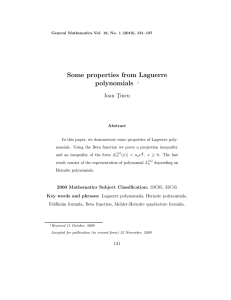
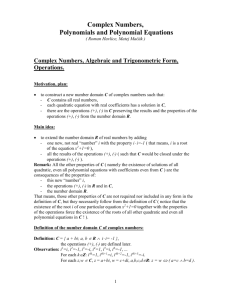
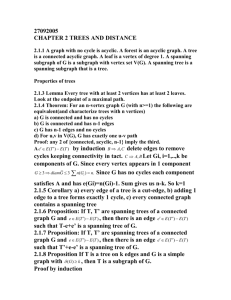
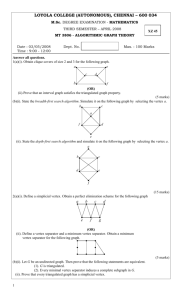

![5.5 The Haar basis is Unconditional in L [0, 1], 1 < 1](http://s2.studylib.net/store/data/010396305_1-450d5558097f626a0645448301e2bb4e-300x300.png)


